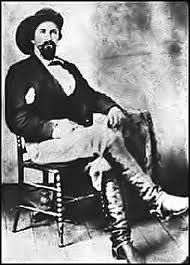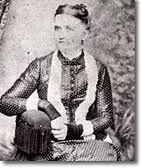 A Tennessee widow’s revenge, for her husband’s execution, led to General John Hunt Morgan’s demise. Confederate Cavalry General John Hunt Morgan began his Civil War career as a chivalrous, dashing, southern gentleman, but eventually sunk to the depths of Rebel terrorist, thief and murderer. His daring escapades, raiding behind the Union lines, have been glorified in movies, books and southern heritage lore. However noble Morgan’s initial motives were, somewhere mixed in the fog of war, the frustrations of a lost cause, created a legion of pillagers that terrorized the Pro-Union residents of East Tennessee. Morgan’s depredations finally ended, with his bloody demise at Greeneville, Tennessee, in September, 1864 and was the result of the life he led and the relentless revenge of a Tennessee widow.
A Tennessee widow’s revenge, for her husband’s execution, led to General John Hunt Morgan’s demise. Confederate Cavalry General John Hunt Morgan began his Civil War career as a chivalrous, dashing, southern gentleman, but eventually sunk to the depths of Rebel terrorist, thief and murderer. His daring escapades, raiding behind the Union lines, have been glorified in movies, books and southern heritage lore. However noble Morgan’s initial motives were, somewhere mixed in the fog of war, the frustrations of a lost cause, created a legion of pillagers that terrorized the Pro-Union residents of East Tennessee. Morgan’s depredations finally ended, with his bloody demise at Greeneville, Tennessee, in September, 1864 and was the result of the life he led and the relentless revenge of a Tennessee widow.
John Hunt Morgan, born in 1825, grew up outside Lexington, Kentucky. Morgan’s wealthy, agrarian, aristocratic relatives, provided young Morgan with a 2 year college education and his free time was spent raising, training and racing the numerous horses on the farm. Morgan and several of his cousins enlisted in the 1st Kentucky Cavalry at the outbreak of the Mexican War. He served under Zachary Taylor and saw action at Buena Vista. Returning to Kentucky, after the war, he successfully grew and maintained a hemp factory, on the side he raised his own militia, the Lexington Rifles, funding it from his own wallet.
As rumors of succession spread, Morgan initially feared that disunion would impact his burgeoning hemp trade and spoke briefly against the political divide. His pro-southern proclivities prevailed and John Hunt Morgan led his mounted militia into Tennessee and joined the Confederate Army, as a Colonel of the 2nd Kentucky Cavalry.
The 2nd Kentucky was engaged in the battle of Shiloh in 1862 and participated in many daring raids, disrupting Union supply lines, burning bridges and capturing hundreds of Union troops in Tennessee and Kentucky. In July of 1862, Morgans Cavalry left Knoxville, Tennessee, with nearly 1000 men and raided through Kentucky capturing over 1200 Union prisoners, disrupting communications and destroying supply trains. In December John Hunt Morgan was promoted to Brigadier General and led another raid north to distract the Union Army of the Cumberland. He returned south and was proclaimed a Confederate hero, garnering the nickname, The Thunderbolt of the Confederacy.
In June of 1863, Morgan and his elite cavalry left Sparta, Tennessee, with a force numbering in excess of 2300 and a battery of artillery, for another raid into Kentucky. General Braxton Bragg, fearing Morgan’s aggressive tendencies, gave explicit orders not to move North of the Ohio River. John Hunt Morgan and his troopers captured two steamers at Brandenburg, Kentucky and immediately crossed the Ohio River into Indiana. Morgan’s forces began a daring ride across southern Indiana and Ohio, that terrified the Northern residents and made headlines nationally as The Great Raid. General Ambrose Burnside sounded the alarm and dispatched several units that captured the majority of Morgan’s forces and the remaining 400 were taken prisoner after a skirmish at The Battle of Salinesville. John Hunt Morgan and his officers, were imprisoned at Columbus, Ohio and after 3 weeks succeeded in a miraculous escape, crossing the Ohio River at Cincinnati and with the help of Southern partisans in Kentucky, regained the Confederate lines.
General Morgan returned again a Southern hero and patriot. However, Braxton Bragg would never trust Morgan again after disobeying his direct orders. The Thunderbolt of the Confederacy was banished to a command in Eastern Tennessee, in 1864 and recruited the dregs of the Appalachian region, mainly thieves and cutthroats that were more inspired by personal gain, than Southern Patriotism. Some of Morgan’s elite were accused of robbing a local bank and while trying to clear his name, John Hunt Morgan took refuge in the town of Greeneville, Tennessee.
 Sarah E. Thompson and her husband Sylvanius, of Greenville were pro-Union supporters. As early as 1861 Sarah and her husband were recruiting Federal troops from their region and gathering Confederate intelligence for the Union command. Both knew the personal ramifications of harboring Union sentiment and late one night, in 1864 a knock on their cabin door resulted in Sarah’s husband being dragged out and shot by Confederate troops. Instead of wallowing in her grief, Sarah vowed revenge and worked harder than ever to support the Union cause.
Sarah E. Thompson and her husband Sylvanius, of Greenville were pro-Union supporters. As early as 1861 Sarah and her husband were recruiting Federal troops from their region and gathering Confederate intelligence for the Union command. Both knew the personal ramifications of harboring Union sentiment and late one night, in 1864 a knock on their cabin door resulted in Sarah’s husband being dragged out and shot by Confederate troops. Instead of wallowing in her grief, Sarah vowed revenge and worked harder than ever to support the Union cause.
The widow Thompson heard that General Morgan was encamped in Greeneville and told the following account,
“I took my sunbonnet in hand and went to the street and met Colonel Williams and after I had passed the time of day I asked him to pass me out after my cow as there was several cows on the hill. He told the guard to pass me out and to pass me in when I returned and I would give him some milk. So I was through the enemies lines and went on after the cow. When I got to it I threw (a rock) at her and she went down the hill and I went after her. When I was out of sight, I crossed over in a corn field and went to a friend’s house that had aided me more than one time and got a horse and went to our forces that were at Bulls Gap.
I sent word into our forces. When Gillem who was general heard the news he did not believe it as he said it was a woman’s tale. The colonel of the 3rd Tennessee whose name is Brownlow and the 10th Michigan and seven others said they would go. After they talked and at last they started though I must say Gillem did not deserve any of the honor of that great deed for had it been left to him he would not have went and when he did go he went behind so far there was no danger of any harm in anyway coming at him.”
Sarah led the Union troopers into Greeneville and identified General John Hunt Morgan, hiding behind a fence on the main thorough fare. The Federals, not taking any chances with The Thunder Bolt of the Confederacy, immediately shot him dead.
After the war, Sarah E. Thompson had a tough time financially, supporting herself and her two children. Sarah earned some money lecturing on her Civil War adventures and petitioned the Government for a pension, eventually receiving $12 a month. Upon her death she was buried at Arlington National Cemetery.
If there is a moral to this story, it would have to be……never discount the tenacity of a Tennessee widow’s revenge or the real tale of General Morgan’s Demise.
Bummer


There’s also an interesting story behind the man credited with shooting Morgan, and I’ve been thinking about taking that subject on in another post. The man, however, was not a native of Tennessee, but rather an Irishman.
Robert,
There are so many tales, at least from Bummer’s kin in the Smokey’s, it’s almost like, if there not all true, they should be! The “old guy” grew up on stories from the mountain folks and love them all, sometimes it’s just hard to remember them all. An Irish tale regarding Morgan would be a “great tell”! Hope you go for it.
Bummer
Interesting story.
Pat,
Thanks for the read. Glad you stopped by. Enjoying your recent blogs, especially on the Nursing Nuns.
Bummer